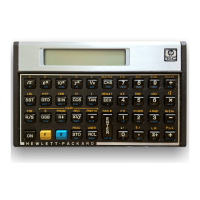HP-15C
SOLVE in a
program
If SOLVE can find a root the next program line is executed, otherwise
skipped
Misc
• To speed up the root finding process rewrite your function f(x) so
that it returns 0 if |f(x)|<ε. Or count the number of iterations inside
the calculation of f(x) and stop when a limit has been reached
• Even if no root can be found the stack registers contain the above
mentioned values. These often give a hint why the root finding
failed
• To find multiple roots eliminate an already known root R by dividing
the function by (x-R)
• Fore more details see HP-15C Owner's Handbook, Appendix D,
pg.220ff and The HP-15C Advanced Functions Handbook
Numerical Integration
Memory The integrator needs 23 registers. These are allocated from the uncommitted
registers space, see MEM.
The integrator and the solver (see above) share their registers
∫
x
y
0-9,
.0-.9, A-E
Integrates function f(X) at the given label for X values running from Y to X
• ∫
x
y
makes repeated GSB calls to the specified label with the current X
value being present in the stack's X, Y, Z and T register
• The program at the label must calculate the function f(X) and return the
result in X before it executes the RTN
• When ∫
x
y
ends the stack wil contain these values:
X: The integral of f(x)
Y: The uncertainty of the result: ∫
x
y
f(x) = X±Y
Z: Upper integration limit
T: Lower integration limit
• Note that ∫
x
y
eats up two of the seven possible GSB levels: One for ∫
x
y
and
one for the calls to the user function
• The program which calculates f(x) must not call ∫
x
y
(no nesting). However,
SOLVE and ∫
x
y
can be nested
Accuracy The integral is only evaluated to the accuracy specified by the current FIX,
SCI or ENG format! The more digits have been specified the more accurate
the integral will be – but calculating it will take longer
Misc
• Initially, ∫
x
y
will evaluate f(x) only at a few sample points. Then the
number of sample points are increased until the calculated integral
doesn't change any more. This has one important consequence: The
integration limits should be close to the area where the function is
"interesting". Ie. exp(-x²) around x=0 – if this function is integrated from
1E-50 to 1E+50 then the result will be 0 because the algorithm missed
the interesting part around 0
• Fore more details see HP-15C Owner's Handbook, Appendix E, pg.240ff
and The HP-15C Advanced Functions Handbook
11

